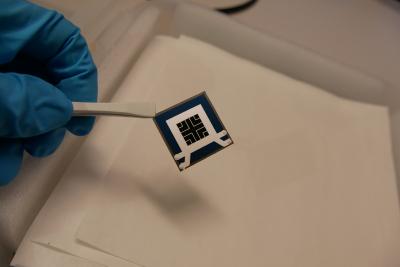A research team at the Fraunhofer Institute for Solar Energy Systems ISE has reported a perovskite/perovskite/silicon triple-junction solar cell with an open circuit voltage of >2.8 V, which is said to be the record value reported for this structure so far. The Fraunhofer team showed that perovskite-perovskite-silicon subcells can hold considerable promise and have an even greater efficiency potential than double-junction tandem cells.
The triple-junction solar cell was developed as part of the Triumph research project funded by the European Commission and the RIESEN research project funded by the German Federal Ministry for Economic Affairs and Climate Action. This achievement confirms that the cell has excellent material properties for generating electricity, leading the scientists to deduce that it has an efficient solar cell architecture.
To design the cell, the team employed a gas quenching method for deposition of the top perovskite layer, as well as optimization of interlayers between perovskite subcells. Moreover, for the measurement of the triple-junction solar cells, precise measurement procedures were implemented to ensure the reliability and accuracy of the reported values.
Traditional silicon solar cells have an open-circuit voltage of between 0.7 and 0.8 volts. “The voltage of over 2.8 volts measured for the perovskite-perovskite-silicon solar cell suggests that the technology is extremely promising for electricity generation,” says Dr. Juliane Borchert, Group Leader for Perovskite-Silicon Technologies at Fraunhofer ISE and at the University of Freiburg, in an announcement on Fraunhofer's website. “This is a record value for this type of solar cell and demonstrates how photovoltaics combining perovskite and silicon offers huge untapped potential.”
The performance of a solar cell is determined by three main factors: the open-circuit voltage, short-circuit current and fill factor. Of these, the open-circuit voltage is most strongly influenced by the intrinsic properties of the materials used. The two other factors are heavily dependent on how well the solar cell is implemented into the system. A high voltage therefore indicates that the basic physical characteristics of the solar cell are appropriate and that the fundamental aspects needed for a very efficient solar cell are in place.
Prof. Dr. Stefan Glunz, Division Director for Photovoltaics at Fraunhofer ISE, commented: “While we are currently in the process of scaling up the development of perovskite-silicon tandem solar cells and readying them for use in industry in our Pero-Si-SCALE project, it’s also fantastic to see how triple-junction solar cells hold so much potential for advancing the concept in the future.”




